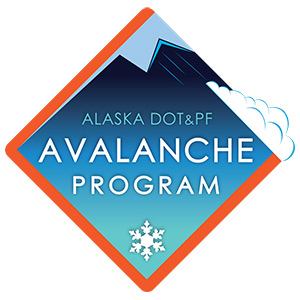
Snow Avalanche Programs
Reducing Avalanche Hazard
The goal of ADOT&PF Snow Avalanche Programs is to improve safety for highway users by reducing the avalanche hazard in areas susceptible to snow avalanches while concurrently minimizing avalanche related traffic delays and road closures.
Avalanches cannot be prevented in all avalanche paths that affect the highway, but the encounter risk can be reduced. To help forecast avalanche hazard and the necessity for temporary traffic delays for avalanche work, ADOT&PF regularly monitors weather, terrain, and snowpack conditions. When conditions are appropriate, specially trained maintenance crews use military artillery and other methods to artificially trigger avalanches on the: Seward Highway, Richardson Highway and Dalton Highway, as well as Thane Road in Juneau. Additionally, ADOT&PF crews near Skagway have begun using an Avalauncher to reduce avalanche hazard.
- Juneau's Thane Road Avalanche Hazard Reduction
- History of Avalanche Work on the Seward Highway
- History of Military Weapons for Avalanche Hazard Reduction 7.3 MB
- Watch video of Alaska DOT&PF crew firing artillery
DART - Drone Avalanche Reduction Tool
The State of Alaska Department of Transportation and Public Facilities (DOT&PF), in collaboration with the Alaska Railroad Corporation (ARRC), proudly announces a major achievement in drone avalanche mitigation technology, utilizing the Drone Amplified DART system on a US made UAS platform. This innovative project, which successfully deployed and detonated two CIL Explosives Classic Snowlauncher rounds in early January, builds upon a foundation of prior technological advancements and collaborative efforts in avalanche mitigation
Some Common Factors that Increase Avalanche Hazard
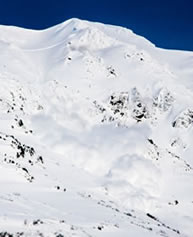
Photo by Kevin Wright
- Large quantities of new snow or rain
- Strong winds
- Rapid changes in temperatures
The potential for avalanches changes constantly, sometimes in a matter of minutes. Not all snowstorms create avalanches, nor are all sunny days free of avalanche occurrences.
- During the winter, the vast majority of avalanches occur during snow/rain storms and within 24 hours following a storm.
- In the spring time, a warm sunny afternoon day can be considered a storm as much as heavy snowfall or heavy rain is in the winter.
Avoiding highway avalanche areas and/or postponing your travel during the times described above will greatly reduce the probability of encountering an avalanche or being delayed for avalanche work on ADOT&PF highways.

Photo by Terry Onslow
Safety in Avalanche Areas
The frequency, extent, and severity of avalanches vary depending on snowpack, weather and terrain. Many of the avalanche areas that affect the highway are marked with signs, please do not stop or step outside of your vehicle in these areas. Most of the avalanches that affect ADOT&PF highways occur between December and March, but they can also hit the highway as early as September and as late as June.
There are many inherent challenges of forecasting exactly where and when avalanches may occur, what size they may be, and how far they may run. Avalanches may affect a highway before traffic can be diverted away from the avalanche hazard area.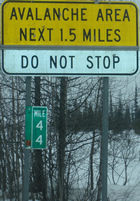
Photo by Matt Murphy
If a naturally triggered avalanche blocks the highway while it is open to traffic, good practices include, but are not limited to, the following:
- Do not attempt to drive through an avalanche regardless of its size.
- Drive away from the avalanche area immediately to a safe area outside of the avalanche area.
- Do not stop or step outside of your vehicle in avalanche areas.
- Notify Alaska State Troopers by calling 911
Know Before You Go
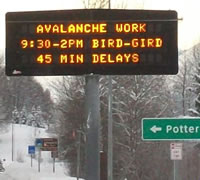
Photo by Preston Hughes
When ADOT&PF conducts avalanche hazard reduction, messages will be posted as “Alerts” on the ADOT&PF 511 system to notify highway users about potential traffic delays. Motorists can visit the website or call 511 for current road and weather information and updates on avalanche work. Electronic sign boards will also be used in some locations to display avalanche notifications.
Since it is difficult to predict how much snow will be brought down during avalanche hazard reduction work, ADOT&PF cannot estimate how long each traffic delay will take. Typically, these intermittent delays last about 45 minutes; however, longer delays are possible. The Seward Highway between Anchorage and Girdwood has been closed for 4 consecutive days due to avalanches. Always travel with extra supplies in the winter in case an avalanche blocks a highway for an extended amount of time. ADOT&PF will re-open the highway to traffic as soon as maintenance crews can safely remove the debris from the highway.
ADOT&PF avalanche hazard reduction work can also impact air traffic. During active artillery work, the FAA will issue Temporary Flight Restrictions. More detailed information for pilots about avalanche blasting can be found in the FAA Supplement for Alaska or by visiting the following website: FAA's Temporary Flight Restrictions.
Off-highway users may also be affected. If traveling off the road system near highway avalanche areas, please remember:
- No parking or stopping in highway avalanche areas
- ADOT&PF Snow Avalanche Operations are specific solely to avalanche paths that affect highways/roads maintained by ADOT&PF. There are countless other avalanche paths in Alaska that affect: roads maintained by other agencies, industrial/commercial operations, urban areas, trails, or backcountry areas. If traveling to the backcountry for activities like: snowmachining, skiing, snowboarding, hiking, hunting, mining and trapping, recreationalists can find pertinent information at:
- Avalanche.org
- Forest Service National Avalanche Center
- American Avalanche Association
Sign up for our GovDelivery service to get notification of alerts for avalanche related traffic delays or road closures

- Recreation in areas where avalanche blasting occurs for highway operations is strongly discouraged for your safety. Avalanche blasting with long range weaponry may occur without warning for a backcountry traveler (see maps for locations).
- Please note that the Alaska State Parks Bike Path between Bird and Girdwood is intermittently closed during the winter (November-May) for avalanche blasting operations. Please read the warning signs.
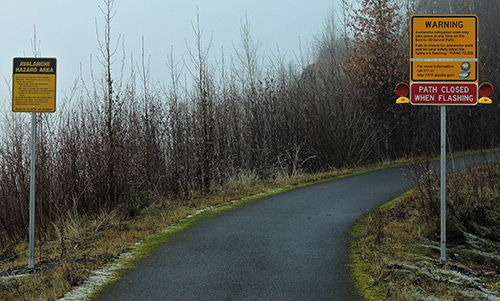
Unexploded Ordnance
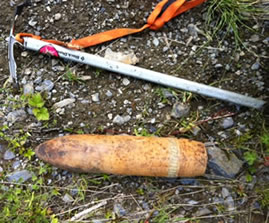
Photo by Matt Murphy
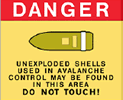 Occasionally artillery ordnance does not explode upon impact. Unexploded artillery ammunition or “duds” occur infrequently; but, they do pose a potential risk to hikers and others that might stumble upon them in the mountains where avalanche blasting occurs (see maps for locations). If you find any unexploded ordnance, DO NOT TOUCH IT. Mark its location from a safe distance away with a GPS, rock pile, or bright cloth. It also helps to take a photo of the ammo from a safe distance showing its surrounding area so that it may be found quickly and safely destroyed by Explosive Ordnance Disposal personnel. Report the location of the unexploded ordnance immediately to ADOT&PF at the numbers listed below or to an employee listed in the Contact Information at the bottom of the page:
Occasionally artillery ordnance does not explode upon impact. Unexploded artillery ammunition or “duds” occur infrequently; but, they do pose a potential risk to hikers and others that might stumble upon them in the mountains where avalanche blasting occurs (see maps for locations). If you find any unexploded ordnance, DO NOT TOUCH IT. Mark its location from a safe distance away with a GPS, rock pile, or bright cloth. It also helps to take a photo of the ammo from a safe distance showing its surrounding area so that it may be found quickly and safely destroyed by Explosive Ordnance Disposal personnel. Report the location of the unexploded ordnance immediately to ADOT&PF at the numbers listed below or to an employee listed in the Contact Information at the bottom of the page:
Timothy Glassett
timothy.glassett@alaska.gov
907-269-0763
Avalanche Maps
- Google Earth map showing 60 common avalanche areas that affect ADOT&PF Highway and Road Alignments throughout the state. Zoom in to the area where you plan to drive to see the locations and mileposts of the areas marked in orange polygons where ADOT&PF maintained roads have historically been hit by snow avalanches.
(Please note: this is a 3.1mb KMZ file and requires a KML viewer such as Google Earth) free Google Earth download
- Atigun Pass FAA Blasting Map
- Juneau FAA Avalanche Blasting Map
- Skagway FAA Avalanche Blasting Map 4MB
- Thompson Pass FAA Avalanche Blasting Map
- Turnagain Arm FAA Avalanche Blasting Map
Seward Highway Snow Avalanche Maps
*Note-the maps below show most but not all avalanche paths that affect the roadway
- Mileposts 18-23 4.5 MB
- Mileposts 29-50 6.4 MB
- Mileposts 59-107/Hope Road/Portage Road 5.7 MB
Avalanche Research
ADOT&PF is committed to improving the effectiveness of its Snow Avalanche Operations. In addition to being a member of the Avalanche Artillery Users of North America Committee, ADOT&PF has also been an active participant with the International Snow Science Workshop (ISSW). ISSW has been the ongoing forum for state of the art avalanche research since 1976. A database of all ISSW Papers and Abstracts are available online thanks to: Montana State University, the ISSW Steering Committee, Canadian Avalanche Association, and the American Avalanche Association.
Alaskan Transportation Avalanche Research
Contact information
General Questions about the Statewide Avalanche Program or contacts for Seward Highway Avalanche ProgramTimothy Glassett
South Coast
|
Richardson Highway Avalanche ProgramVacant
Dalton Highway Avalanche ProgramGordon Scott
Statewide Artillery Program ManagerTimothy Glassett |
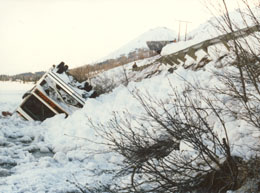
5/1/1988 Motorhome pushed off the road and into lake near milepost 45 Seward Highway. Alaska DOT&PF Photo
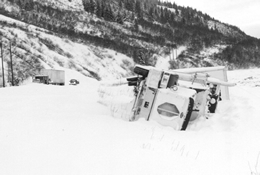
2/20/1995 Truck knocked over by avalanche air blast near milepost 98 Seward Highway. Alaska DOT&PF Photo

Alaska DOT&PF Photo

Avalanche control on Seward Highway at MP37, Tern Lake.
Photo by Ken Bartlett, Alaska DOT&PF

